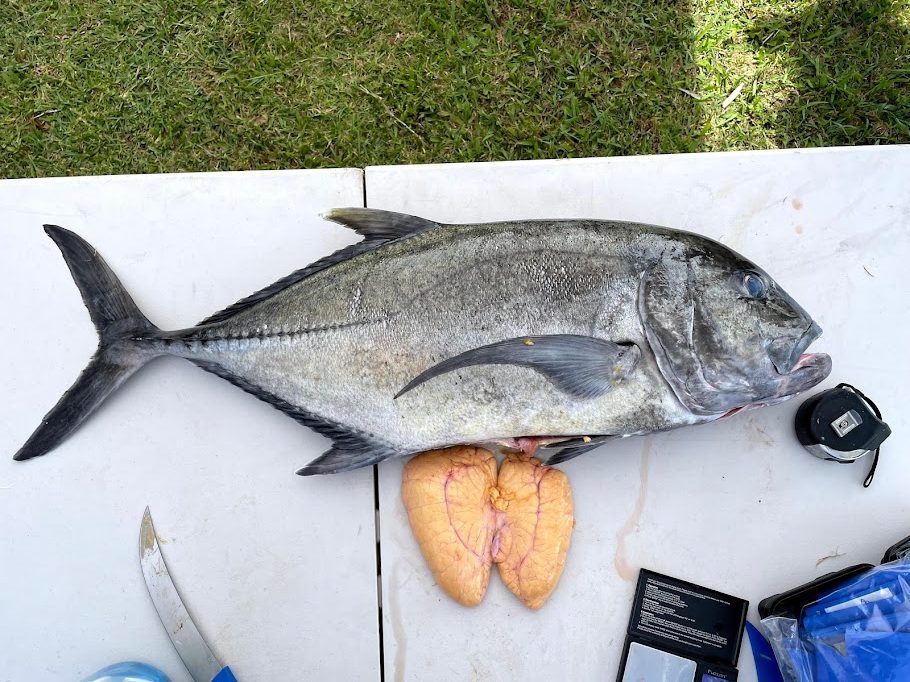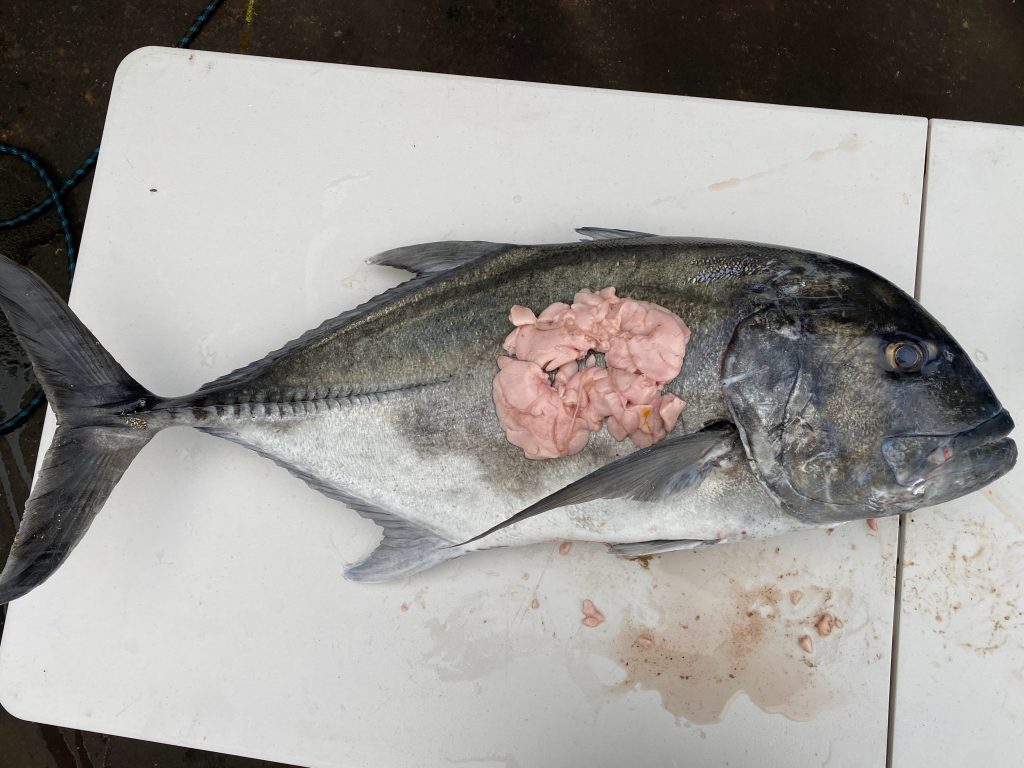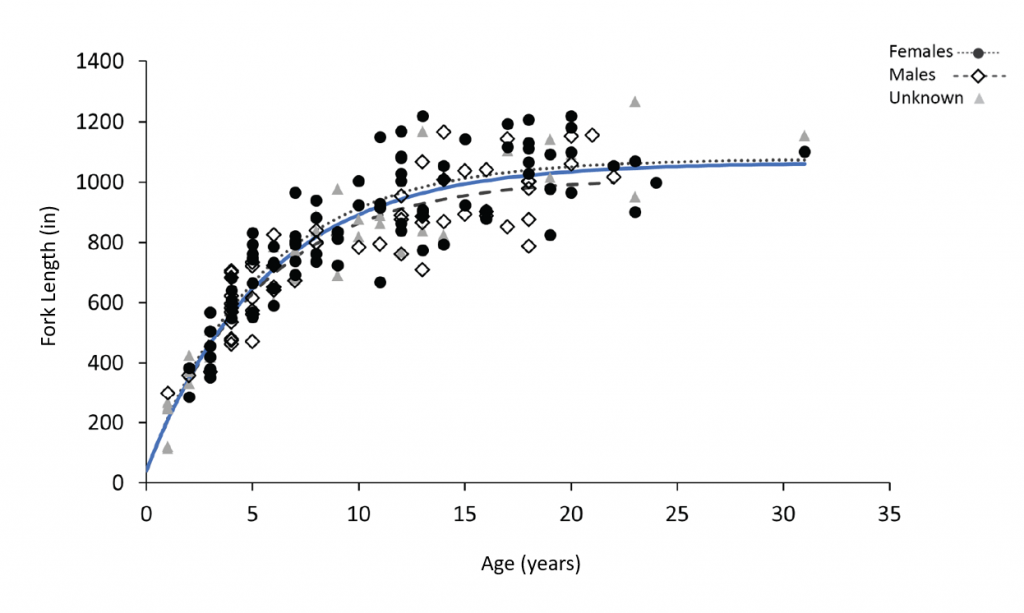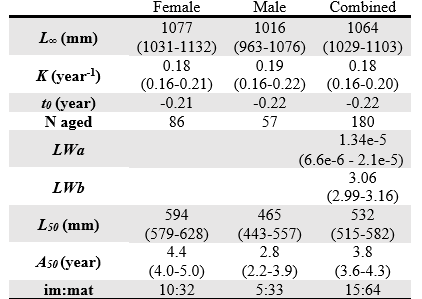Ulua Aukea
Giant Trevally
Caranx ignobilis
Family: Carangidae


Most jacks are known in Hawaii based on their growth stages: pāpio (young, less than 10 pounds) and ulua (adult) (Gaffney, 2000). The giant trevally, Caranx ignobilis, is the largest of the jacks and is referred to as ulua aukea, or white ulua. The largest individual captured in Hawaiian waters was shot by a spear fisherman setting the state record at 191 lbs!
These fish are distinguished by their silvery color, often with dark spots, a steep head profile, and strong tail scutes. Male and female ulua aukea look mostly identical, but large males may get darker in color especially near spawning time, appearing dark gray or black.
Historically, ulua were considered an important fish for ancient Hawaiians, and were seen as sacred and used in religious ceremonies (Gaffney, 2000). Only ali’i, or hereditary nobles, would fish ulua for sport. They were likened to fine men and warriors due to their strength, which may be why it was considered taboo for women to eat ulua, and could even be killed if caught eating one (Titcomb, 1972).
In the 1980s, several ciguatera poisoning cases were linked to jacks as a whole; ultimately, these fish were largely removed from major public markets (Friedlander & Dalzell, 2004). In turn, many commercial fishermen stopped targeting them. The reported commercial landings for all jacks declined from almost 300,000 kgs in the 1900’s to under 50,000 kgs in 1984 (Tagawa & Tam, 2006). Widely considered the ultimate shoreline fish, the non-commercial catch of jacks is estimated to be over 3 times that of the commercial fishing sector (McCoy, 2015), and may contribute as much as $31 million per year to Hawaiʻi’s economy (Honebrink, 2000).
Regulations: Legal size limits for harvesting: 10 inches SL for home consumption and 16 inches SL for sale. Additionally, bag limits allow 20 fish to be caught per day (non-commercial).
Habitat: Ulua are highly-mobile predators that range throughout the Indo-Pacific from brackish estuarine waters to offshore reefs (Gaffney, 2000; Holland et al., 1996). Ulua are typically found at depths between 6 – 500 feet and are considered semi-pelagic, meaning they spend their time in both open ocean as well as coastal waters. As juveniles they can be found in schools inshore often by inputs of fresh water, but as they mature, they begin foraging in deeper waters.
Diet: Ulua eat mainly fish such as uhu (parrot fish), eels, and mullet. Smaller individuals have been shown to eat more crab, lobsters, octopus and squid compared to larger individuals. Most of their hunting is done at night. They have even been filmed hunting birds!
Age and Growth: Papio ranging in size from 5-15 inches FL can grow 1-2 inches per month when food is prevalent during the summer months; the rate can drop to 0.2 inches per month in December; larger fish ranging from 25.9-51 inches FL average 1 inch growth per year (Tagawa & Tam, 2006). Combined sex VBGF values for ulua aukea: L∞= 1064 mm and K = 0.18 year-1 (Pardee et al. 2021).
Sex specific maximum ages for ulua aukea are 31 years for females and 22 years for males (Pardee et al. 2021).
Reproduction: Ulua reproduce using a method called “broadcast spawning” in which both males and females gather in large groups to release and fertilize eggs in the water column. Spawning aggregations of Ulua aukea are thought to be dependent on moon phases and seasonality. Cultural knowledge points to spawning events happening around the full moon. Spawning peaks are currently believed to occur from May – August.
Size at maturity for females occurs at 23.4 inches FL, over 5 inches greater than males, whose L50 is 18.3 inches. Females age at maturity is 4.4 years, compared to males A50 of 2.8 years (Pardee et al. 2021).
References:
Gaffney, R. (2000). Evaluation of the status of the recreational fishery for ulua in Hawaii, and recommendations for future management. 35 pp. Honolulu.
Titcomb, M. (1972). Ulukau: Native use of fish in Hawaii. University of Hawaii Press.
Honebrink, R. R. (2000). A review of the biology of the family Carangidae, with emphasis on species found in Hawaiian waters. Hawai’i Department of Land and Natural Resources, Division of Aquatic Resources. https://dlnr.hawaii.gov/dar/files/2015/08/ulua01.pdf
Tagawa, A. W., & Tam, C. K. M. (2006). Hawaii’s Ulua and Papio Tagging Project 2000 to 2004. Hawai’i Department of Land and Natural Resources, Division of Aquatic Resources, 81.
Friedlander, A. M., & Dalzell, P. (2004). A review of the biology and fisheries of two large jacks, ulua (Caranx ignobilis) and omilu (Caranx melampygus), in the Hawaiian Archipelago. Status of Hawaii’s Coastal Fisheries in the New Millennium.
McCoy, K. S. (2015). Estimating Nearshore Fisheries Catch for the Main Hawaiian Islands. A Thesis submitted to the graduate division of the University of Hawaii at Manoa. University of Hawaii at Manoa, 57 pp.
Holland, K. N., Lowe, C. G., & Wetherbee, B. M. (1996). Movements and dispersal patterns of blue trevally (Caranx melampygus) in a fisheries conservation zone. Fisheries Research, 25, 279–292.
Pardee, C., Wiley, J., & Springer, S. (2021). Age, growth and maturity for two highly targeted jack species: Caranx ignobilis and Caranx melampygus. Journal of Fish Biology, 99(4), 1247– 1255. https://doi.org/10.1111/jfb.14828
Growth Curve

Life History Parameters

